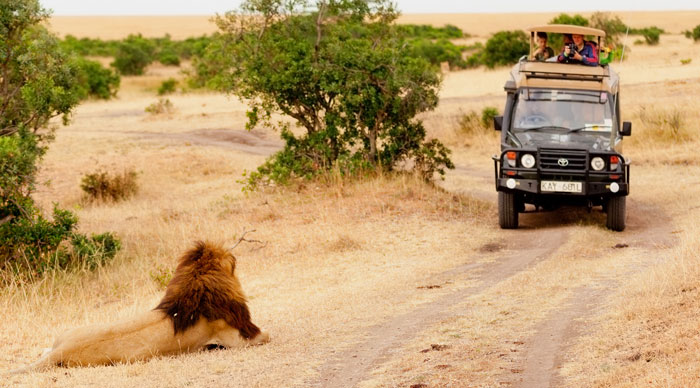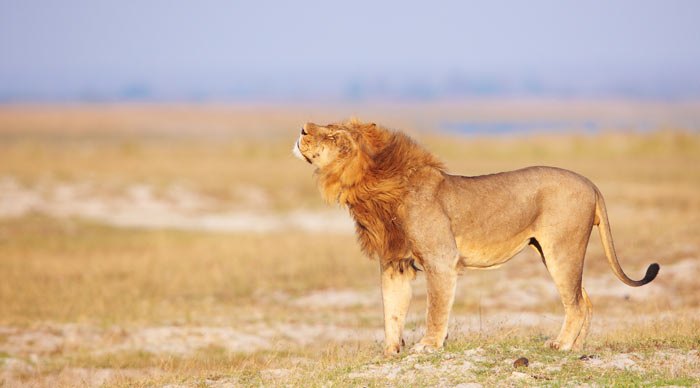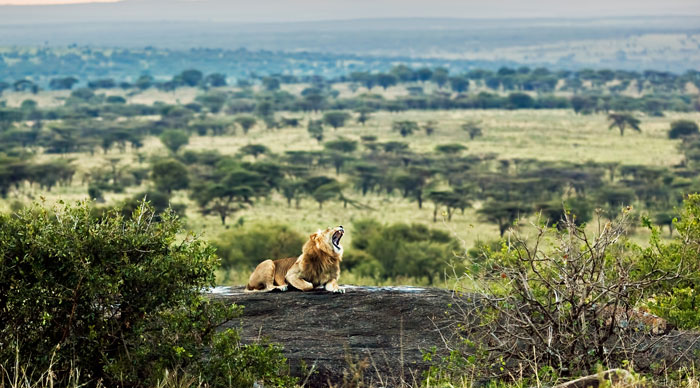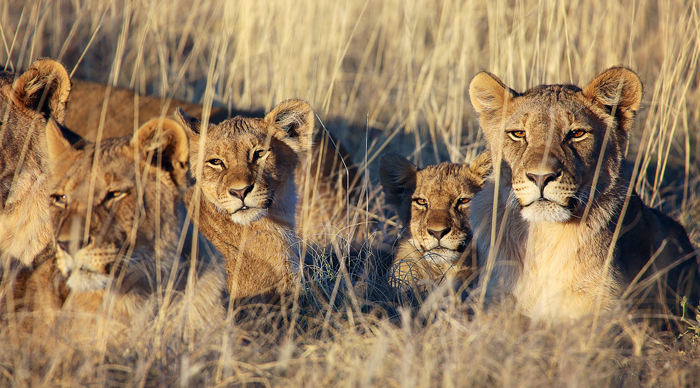Africa is a unique continent in many aspects – geography, topology, landscape, people, culture and traditions. But, the one thing that sets Africa apart from any other continent is the abundance of wildlife here. Not only are there large numbers of animals and birds that call Africa their home, but they are completely wild and live in their own natural habitats –places they have called home for hundreds of thousands of years. This untamed wilderness combined with the sheer variety of flora and fauna make Africa a dream destination for any nature enthusiast.
When it comes to African wildlife there are quite a few plants and animals that are only found on this continent including giraffe, two-horned rhino, African elephant, wildebeest, and hundreds more. However, none conjure the feeling of Africa as much as the lions.
Facts about African lions:

- African lions live, hunt and breed in prides which sets them apart from almost all of the other big cats who are all solitary hunters.
- Lions are extremely efficient nocturnal hunters. With just a few exceptions, all lions hunt as a group at night. They take advantage of low-visibility at night, and with stealth and teamwork, they approach their prey at a close distance. This gives them a tremendous advantage than during daylight when it’s impossible to hide in the plains.
- They spend their days lazily lying about in the shades on the grassy plains, perhaps digesting their last night’s kill.
- Males act as protectors, defending their pride from other animals, especially other male lions. Females adopt the roles of hunters. Raising cubs is more of a group effort involving all of the adult members of a pride.
- Each pride has one male leader (or sometimes two brothers) who impregnates all of the females in the pride. All the offspring in a pride belong to the leader of the pride. When another male takes over the pride by killing or chasing away the older leader, he will proceed to kill each and every offspring of the previous leader (and sometimes cannibalize them).
Lion populations: then and now

Lions have, historically, been an extremely successful species and about 10,000 years ago the lion was the most widespread large mammal after humans. They lived in all the continents of the world. However, all is not rosy when it comes to the lion population statistics in Africa today. Lions have lost over 75 percent of their former range and are extinct in 26 African countries. Most of the continent’s lions survive in just six countries – Kenya, Zambia, Tanzania, South Africa, Zimbabwe and Botswana. Lion populations have decreased more than 65 percent in the past 30 years and now number less than 32,000.
Tourism has played a significant role in the conservation of lions in Africa. They inject cash into tribal communities making them less reliant on hunting or poaching. International currency earned through tourism also helps nations and counties in their conservation efforts. So, going on an African lion safari is not only an exciting experience for the tourists, it also helps in the conservation and protection of this beautiful animal.
Sub-species of lions

Lion, Panthera Leo, is a distinct species of the cat family and there are several sub-species of lions throughout Africa.
- Barbary lions, formerly found in North Africa, are now extinct.
- Senegal lion, the smallest of the sub-Saharan lions, found in western Africa from Senegal to the Central African Republic. It is currently listed as critically endangered.
- Congo lion, found in the northeastern parts of the Congo, is another sub-species that’s on the brink of extinction.
Other sub-species have relatively healthy populations and are protected by states and individuals alike. These are:
- Transvaal lions (southeastern Africa)
- Maasai lions (east Africa)
- Katanga lions (southwestern Africa)
Top 7 parks and reserves for African lion safaris:

Thousands of people throng to African parks and reserves to embark on a genuine African lion safari. Many tour operators offer lion and big game safaris in Africa and they vary widely in price, options and amenities. So, you are bound to find a safari that’s just right for you whether you are on a budget and pressed for time or you have plenty to spend and have all the time in the world.
- Maasai Mara National Reserve in Kenya is synonymous with African safaris in general and lions in particular. When you go on safaris in Kenya, you are almost always guaranteed a sight of the lions. Lions sightings are reported all year-round, but most people avoid the rainy months of April and May. Lions here mostly feed on abundant herbivores grazing on the rich savannah like gazelle, zebra and eland.
- Serengeti National Park in Tanzania is home to the Maasai lions, hundreds of them. During the wildebeest calving season from December to March, these lions can be seen actively hunting on the plains. Safaris in Tanzania are, undoubtedly, one of the best ways to see lions in their natural habitat.
- Kruger National Park in South Africa is home to Transvaal lions that live in the grasslands of Kruger as well as in semi-arid regions like the fringes of the Namib and Kalahari deserts. These lions may have darker manes and some have white coats due to a color mutation. May to October is considered the best time to go for lion viewing as well as walking safaris. Besides the regular plain herbivores, these lions prey on larger animals like rhinos, giraffes and ostriches and even baboons.
- Botswana’s Okavango Delta is home to Duba Plains lions who are distinct from other sub-species of lions because they stalk in swamps, swim in deep water and hunt by day. Unlike other lions in Africa, the Duba Plains lions hunt cape buffaloes exclusively. July to September provides the best chance to see confrontations between hungry lions and protective buffaloes.
- South Luangwa National Park in Zambia has a group of lions that feed on hippos. Although it is very rare that a lion attacks an adult hippo, these lions have discovered a taste for baby hippos. The lions are found to be actively hunting when the water levels are low. Of course, most of these lions feed on hoofed herbivores found in plenty here. October is a good time to come see these lions hunting when all the game is concentrated along the Luangwa River.
- Mana Pools National Park in Zimbabwe is a great place to go on lion safari especially during August and September before it gets too hot. With the dry season coming up and no rainfall, grazers like zebra, buffalo, and waterbuck are tired and hungry and they gather in their thousands at Mana Pools making themselves easy targets for the lions.
- Skeleton Coast National Park in Namibia is home to several prides of lions with overlapping territories. The lions here have adapted to the extreme desert conditions, commonly hunting oryx and antelope. However, they occasionally wander west to scavenge sea lions and whales on Namibia’s Atlantic coast.
The safest way to see lions in the wild is to go on safari vehicles; but it is not the only way. Some African lion safari providers offer walking safari tours to see lions. Safari goers cling close to each other and approach lions on foot, but from a safe distance. You have to be extremely careful about the noise of your movements and need to follow the safari guide’s instructions to the letter. Although it sounds risky, and it certainly is, using common sense and following the instructions closely will ensure that you have an extremely exhilarating experience of witnessing lions from a close distance without the protection of a vehicle – from as close as 20 meters, but usually from around 50 meters from the lions.
It’s an unmatched experience to go on an African lion safari, witness a kill, see a pride feed and play together. Many wildlife enthusiasts describe it as one of the most captivating scenes in the wild. However, as precious as these views are, they are not hard to find. Africa has massive savannahs and incredibly huge plains where animals can be seen from miles away. African lions, for the most part, are a plains-dwelling species and one is almost guaranteed a sight when one embarks on an African lion safari provided by the many professional companies that operate throughout the region.
As an ending note, Bookmundi recommends you to check out The best safari destinations in Africa that includes some of the most exotic wildlife experiences that the continent has for its visitors.
